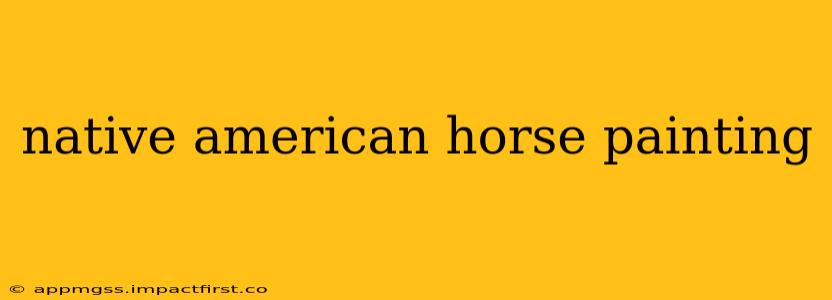The horse holds a profound and multifaceted significance in Native American cultures, far beyond mere transportation. It represents freedom, power, spirituality, and a deep connection to the land. This integral role is beautifully captured in the vibrant and evocative world of Native American horse paintings. From the earliest depictions on hides and rock faces to the contemporary masterpieces adorning galleries, these artworks tell stories of history, tradition, and the enduring spirit of the horse within Indigenous communities.
What Makes Native American Horse Paintings Unique?
Native American horse paintings are distinguished by several key characteristics that set them apart. The artistic styles vary greatly depending on the tribe and the artist's individual approach, but certain elements often recur. These include:
- Stylization: Rather than striving for photorealism, many Native American artists employ stylized representations that emphasize symbolic meaning over precise anatomical detail. This allows the artist to convey deeper cultural significance through form and color.
- Symbolic Imagery: Horses are often depicted alongside other symbols representing elements of nature, spirituality, or clan affiliations. These symbolic additions enrich the narrative and reveal deeper layers of meaning within the artwork.
- Use of Color: The palette often reflects the natural landscape and the artist's cultural background. Earthy tones, vibrant blues, and bold reds are frequently utilized to create dynamic and visually arresting pieces.
- Spiritual Significance: Many paintings reflect the spiritual connection between the horse and the Native American people, depicting them in ceremonial contexts or as representations of power and grace.
What are some famous Native American horse paintings?
While pinpointing specific "famous" paintings can be subjective and depends on individual preferences and access to collections, many talented artists have contributed to the rich legacy of Native American horse paintings. It's crucial to remember that the art often resides within private collections or tribal holdings, and not all works are widely publicized. However, seeking out artwork from recognized artists within specific tribes offers a rewarding pathway to discovering these captivating pieces. Looking at art from museums and galleries featuring Native American art is a great starting point.
How can I learn more about the history and symbolism of horses in Native American cultures?
Understanding the historical context surrounding horses in Native American cultures is crucial for appreciating the depth and complexity of the horse paintings. The introduction of horses to the Americas profoundly impacted the lives and societies of many tribes, altering their hunting strategies, warfare tactics, and social structures. Researching specific tribes and their unique relationship with the horse will offer a richer understanding of the symbolism conveyed in the paintings. Academic journals, books on Native American art and history, and tribal websites are invaluable resources.
Are there different styles of Native American horse paintings?
Absolutely! The diversity of Native American cultures translates directly into a rich diversity of artistic styles in horse paintings. From the geometric patterns of some Southwestern tribes to the more representational styles found elsewhere, the variations are immense and reflect the unique artistic traditions of each community. These stylistic differences are not just aesthetic; they often reflect distinct cultural values and beliefs.
Where can I find Native American horse paintings to buy or view?
Finding Native American horse paintings can involve exploration of various avenues. Museums and art galleries specializing in Indigenous art are excellent starting points. Art fairs and auctions also sometimes feature these works. However, it's vital to ensure authenticity and ethical sourcing when purchasing such art. Support artists directly or purchase through reputable galleries that prioritize fair practices and the preservation of cultural heritage. Remember to research the artist and their background to confirm their cultural connection to the work.
Conclusion
Native American horse paintings represent a powerful and enduring testament to the deep-rooted relationship between humans and horses within Indigenous cultures. These captivating artworks transcend mere aesthetic appeal, serving as windows into a rich tapestry of history, tradition, and spiritual significance. By understanding the cultural context, symbolic imagery, and stylistic variations, we can fully appreciate the beauty and power of these artistic expressions. Further exploration of this captivating genre will reveal the profound legacy of Native American artistic traditions.
